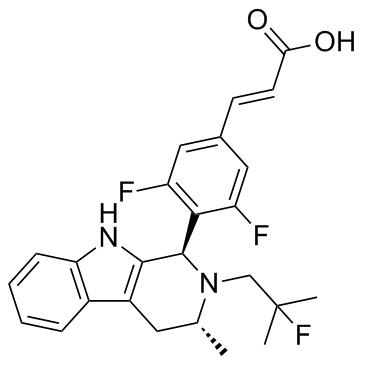1639042-08-2
| Name | (E)-3-[3,5-Difluoro-4-[(1R,3R)-2-(2-fluoro-2-methylpropyl)-3-methyl-2,3,4,9-tetrahydro-1H-pyrido[3,4-b]indol-1-yl]phenyl]acrylic acid |
|---|---|
| Synonyms |
(2E)-3-{3,5-Difluoro-4-[(1R,3R)-2-(2-fluoro-2-methylpropyl)-3-methyl-2,3,4,9-tetrahydro-1H-β-carbolin-1-yl]phenyl}acrylic acid
2-Propenoic acid, 3-[3,5-difluoro-4-[(1R,3R)-2-(2-fluoro-2-methylpropyl)-2,3,4,9-tetrahydro-3-methyl-1H-pyrido[3,4-b]indol-1-yl]phenyl]-, (2E)- AZD9496 |
| Description | AZD9496 is a potent and selective estrogen receptor (ERα) antagonist with an IC50 of 0.28 nM. |
|---|---|
| Related Catalog | |
| Target |
IC50: 0.28 nM (ERα antagonism), 0.14 nM (ERα downregulation), 0.82 nM (ERα binding)[1] |
| In Vitro | The potency of AZD9496 with IC50 of 0.82 nM, 0.14 nM, and 0.28 nM in ERα binding, downregulation, and antagonism, respectively. AZD9496 significantly inhibits MCF-7 cell growth with EC50 of 0.04 nM[1]. Selectivity of AZD9496 over other tested nuclear hormone receptors is high: androgen receptor (AR), IC50=30 μM; glucocorticoid receptor (GR), IC50=9.2 μM; progesterone receptor (PR), IC50=0.54 μM[2]. |
| In Vivo | Significant tumor growth inhibition is observed as low as 0.5 mg/kg dose in the estrogen-dependent MCF-7 xenograft model, where this effect is accompanied by a dose-dependent decrease in PR protein levels, demonstrating potent antagonist activity. Combining AZD9496 with PI3K pathway and CDK4/6 inhibitors lead to further growth-inhibitory effects compared with monotherapy alone. AZD9496, given once daily orally at 5 and 25 mg/kg produced statistically significant increases in uterine weight compared with the fulvestrant control (P<0.001) but significantly lower than tamoxifen (P=0.001)[1]. AZD9496 is also tested in a long-term estrogen deprived model (LTED), using the HCC-1428 LTED cell line that grows in the absence of estrogen and is thought to best represent a model of aromatase inhibition. AZD9496 shows significant activity, with a dose of 5 mg/kg giving tumor regressions in this model[2]. |
| Cell Assay | Effect of AZD9496, Fulvestrant, and Tamoxifen on ERα peptide turnover in MCF-7 cells. Cells are grown in steroid-free conditions in SILAC media containing 13C615N4 L-arginine to label ERα peptide as “heavy” (blue line) and then switched to grow in media containing unlabeled L-arginine to label newly synthesized protein as “normal” (red line) with 0.1% DMSO, 300 nM Tamoxife, 100 nM AZD9496, or 100 nM Fulvestrant for the time indicated. Data shown is representative of two independent experiments[1]. |
| Animal Admin | Mice[1] In vivo efficacy of AZD9496 in MCF-7 xenograft model. MCF-7 xenografts, grown in male SCID mice, are dosed daily with either PEG/captisol (vehicle) or AZD9496 (0.02, 0.1, 0.5, 10, and 50 mg/kg, p.o., q.d.). Tumor growth is measured by caliper at regular intervals and mean tumor volumes plotted for each dosed group. |
| References |
| Density | 1.3±0.1 g/cm3 |
|---|---|
| Boiling Point | 541.0±50.0 °C at 760 mmHg |
| Molecular Formula | C25H25F3N2O2 |
| Molecular Weight | 442.473 |
| Flash Point | 281.0±30.1 °C |
| Exact Mass | 442.186798 |
| LogP | 5.40 |
| Vapour Pressure | 0.0±1.5 mmHg at 25°C |
| Index of Refraction | 1.612 |
| Storage condition | -20℃ |
